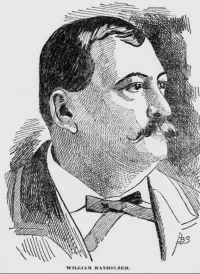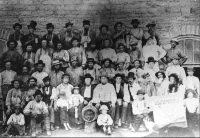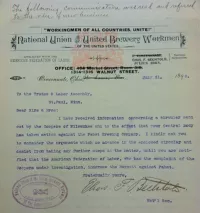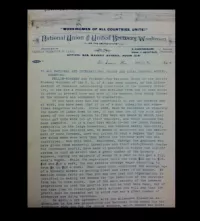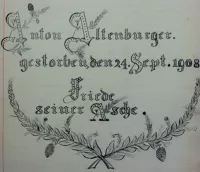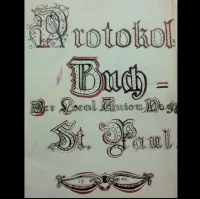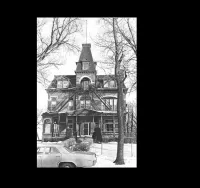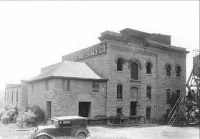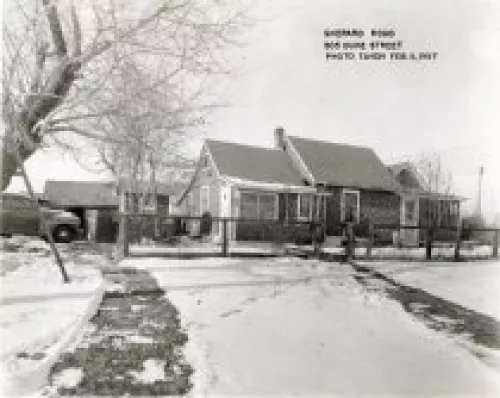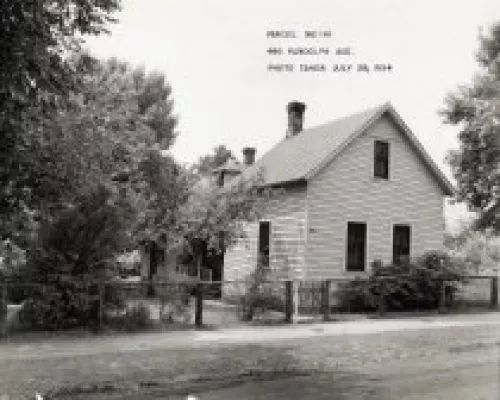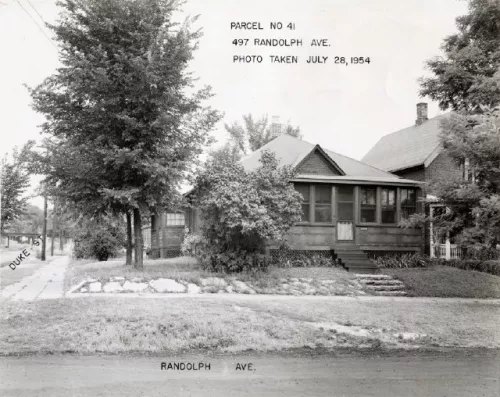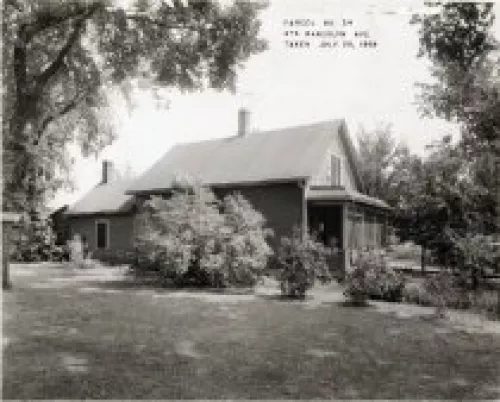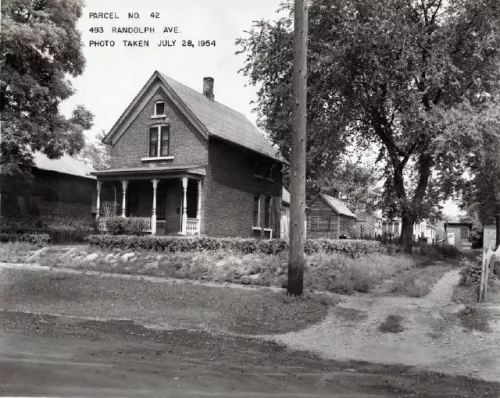Share what you know,
and discover more.
Share what you know,
and discover more.
Jun 01, 1848
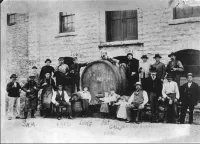
-

- Charmaine Bantugan
543 West James Avenue, Saint Paul, MN, USA
Brewery Workers, Bosses and Consumers By Dave Riehle German workers and German bosses had a monopoly on brewing beer in St Paul, as they did almost everywhere in the United States in the 19th and early 20th centuries. As historian Gary Brueggeman has explained (“Beer Capital of the State-St Paul’s Historic Family Breweries”) St Paul had several advantages: It had the largest German population in the state, including many skilled “braumeisters” who emigrated here as early as the 1840’s, bringing their tradition of creating, distributing and consuming “lager” beer. Unlike the venerable ale, which is brewed warm, lager beer requires cold temperatures for brewing and must be stored at temperatures in the 40’s for aging. “Lager” in fact is the German word for “storehouse.” St Paul conveniently afforded ready-made facilities for cold storage: sandstone caves which maintained constant temperatures year round. Additional storage could be readily excavated out of the soft stone composing the bluffs along the river. Brewing began here as early as 1848 with the establishment of Anthony Yoerg’s brewery in the Seven Corners vicinity. Breweries on the West End included the North Mississippi Brewery, owned by the Banholzer family, whose Teutonic mansion at 689 Stewart Ave still stands, although the brewery was closed in 1904. “Banholzer Park,” located nearby, included a beer garden (of course) and other amenities, and was the site, on several occasions, of the official Labor Day celebration hosted by the St Paul Trades and Labor Assembly. Of course the buildings composing the mighty Schmidt Brewery, which lasted into the present era, are still there on West Seventh Street, as is the “Marie Schmidt Bremer House” at 855 W 7th St, originally built by brewer Christopher Stahlmann. The Brewery Workers Union conducted its local affairs entirely in German—tough luck for the handful of brewery workers who spoke languages other than German. The national organization in particular reflected the influence and inspiration of the Marxist German Social Democratic Party, inscribing at the top of its letterhead, “Workers of the World Unite!” The minutes of Local 97 denominate their members as “genosssen,” the same term used for membership in the German socialist party, the equivalent of “comrade” in English. And, perhaps more significantly, the Brewery Workers, joined by the United Mine Workers of America, were the only unions in the craft union-based American Federation of Labor that organized on an industrial basis, taking in every worker in the industry, whether a braumeister, a maltster, an stationary engineer, a teamster, a laborer, or, apparently, a saloon owner, although the national union constitutionally barred the latter from membership. The records of Local 97 show Hubert Theissen, who owned a saloon at 497 Wabasha, and Paul Grimm, a saloon operator at 700 Reaney, as members in good standing. Of course, these men may have also been employed at one or another of the numerous breweries in the city, and merely run their saloon out of a room in their homes. In 1908 the “schatzmeister,” or treasurer (literally “treasure master”) of Local 97 was George Tschida Jr. of the well known and extended St Paul family. He was employed by the Hamm’s brewery. The Tschidas were part of a German speaking minority in the Austro-Hungarian Empire that emigrated, or re-emigrated to the United States in the late 19th century. Workers at West End breweries, selected more or less at random from scattered records, include local union secretary Peter Lipp, employed by the Melchior Funk Brewery, which once stood at the corner of what is now Colburne and Palace. Genosse Lipp boarded at 787 W 7th St. Michael Kellner, a laborer at the Stahlmann brewery, had his residence at 327 Colburne. Of course, there were innumerable workers employed at the giant Schmidt brewing complex over several generations. Cite this Page Dave Riehle, “Brewery Workers, Bosses and Consumers,” Saint Paul Historical, accessed June 27, 2022, https://saintpaulhistorical.com/items/show/245.
543 West James Avenue, Saint Paul, MN, USA
Brewery Workers, Bosses and Consumers By Dave Riehle German workers and German bosses had a monopoly on brewing beer in St Paul, as they did almost everywhere in the United States in the 19th and early 20th centuries. As historian Gary Brueggeman has explained (“Beer Capital of the State-St Paul’s Historic Family Breweries”) St Paul had several advantages: It had the largest German population in the state, including many skilled “braumeisters” who emigrated here as early as the 1840’s, bringing their tradition of creating, distributing and consuming “lager” beer. Unlike the venerable ale, which is brewed warm, lager beer requires cold temperatures for brewing and must be stored at temperatures in the 40’s for aging. “Lager” in fact is the German word for “storehouse.” St Paul conveniently afforded ready-made facilities for cold storage: sandstone caves which maintained constant temperatures year round. Additional storage could be readily excavated out of the soft stone composing the bluffs along the river. Brewing began here as early as 1848 with the establishment of Anthony Yoerg’s brewery in the Seven Corners vicinity. Breweries on the West End included the North Mississippi Brewery, owned by the Banholzer family, whose Teutonic mansion at 689 Stewart Ave still stands, although the brewery was closed in 1904. “Banholzer Park,” located nearby, included a beer garden (of course) and other amenities, and was the site, on several occasions, of the official Labor Day celebration hosted by the St Paul Trades and Labor Assembly. Of course the buildings composing the mighty Schmidt Brewery, which lasted into the present era, are still there on West Seventh Street, as is the “Marie Schmidt Bremer House” at 855 W 7th St, originally built by brewer Christopher Stahlmann. The Brewery Workers Union conducted its local affairs entirely in German—tough luck for the handful of brewery workers who spoke languages other than German. The national organization in particular reflected the influence and inspiration of the Marxist German Social Democratic Party, inscribing at the top of its letterhead, “Workers of the World Unite!” The minutes of Local 97 denominate their members as “genosssen,” the same term used for membership in the German socialist party, the equivalent of “comrade” in English. And, perhaps more significantly, the Brewery Workers, joined by the United Mine Workers of America, were the only unions in the craft union-based American Federation of Labor that organized on an industrial basis, taking in every worker in the industry, whether a braumeister, a maltster, an stationary engineer, a teamster, a laborer, or, apparently, a saloon owner, although the national union constitutionally barred the latter from membership. The records of Local 97 show Hubert Theissen, who owned a saloon at 497 Wabasha, and Paul Grimm, a saloon operator at 700 Reaney, as members in good standing. Of course, these men may have also been employed at one or another of the numerous breweries in the city, and merely run their saloon out of a room in their homes. In 1908 the “schatzmeister,” or treasurer (literally “treasure master”) of Local 97 was George Tschida Jr. of the well known and extended St Paul family. He was employed by the Hamm’s brewery. The Tschidas were part of a German speaking minority in the Austro-Hungarian Empire that emigrated, or re-emigrated to the United States in the late 19th century. Workers at West End breweries, selected more or less at random from scattered records, include local union secretary Peter Lipp, employed by the Melchior Funk Brewery, which once stood at the corner of what is now Colburne and Palace. Genosse Lipp boarded at 787 W 7th St. Michael Kellner, a laborer at the Stahlmann brewery, had his residence at 327 Colburne. Of course, there were innumerable workers employed at the giant Schmidt brewing complex over several generations. Cite this Page Dave Riehle, “Brewery Workers, Bosses and Consumers,” Saint Paul Historical, accessed June 27, 2022, https://saintpaulhistorical.com/items/show/245.
Jun 01, 1848
543 West James Avenue, Saint Paul, MN, USA
Brewery Workers, Bosses and ConsumersBy Dave Riehle
German workers and German bosses had a monopoly on brewing beer in St Paul, as they did almost everywhere in the United States in the 19th and early 20th centuries. As historian Gary Brueggeman has explained (“Beer Capital of the State-St Paul’s Historic Family Breweries”) St Paul had several advantages: It had the largest German population in the state, including many skilled “braumeisters” who emigrated here as early as the 1840’s, bringing their tradition of creating, distributing and consuming “lager” beer. Unlike the venerable ale, which is brewed warm, lager beer requires cold temperatures for brewing and must be stored at temperatures in the 40’s for aging. “Lager” in fact is the German word for “storehouse.”
St Paul conveniently afforded ready-made facilities for cold storage: sandstone caves which maintained constant temperatures year round. Additional storage could be readily excavated out of the soft stone composing the bluffs along the river. Brewing began here as early as 1848 with the establishment of Anthony Yoerg’s brewery in the Seven Corners vicinity.
Breweries on the West End included the North Mississippi Brewery, owned by the Banholzer family, whose Teutonic mansion at 689 Stewart Ave still stands, although the brewery was closed in 1904. “Banholzer Park,” located nearby, included a beer garden (of course) and other amenities, and was the site, on several occasions, of the official Labor Day celebration hosted by the St Paul Trades and Labor Assembly. Of course the buildings composing the mighty Schmidt Brewery, which lasted into the present era, are still there on West Seventh Street, as is the “Marie Schmidt Bremer House” at 855 W 7th St, originally built by brewer Christopher Stahlmann.
The Brewery Workers Union conducted its local affairs entirely in German—tough luck for the handful of brewery workers who spoke languages other than German. The national organization in particular reflected the influence and inspiration of the Marxist German Social Democratic Party, inscribing at the top of its letterhead, “Workers of the World Unite!” The minutes of Local 97 denominate their members as “genosssen,” the same term used for membership in the German socialist party, the equivalent of “comrade” in English. And, perhaps more significantly, the Brewery Workers, joined by the United Mine Workers of America, were the only unions in the craft union-based American Federation of Labor that organized on an industrial basis, taking in every worker in the industry, whether a braumeister, a maltster, an stationary engineer, a teamster, a laborer, or, apparently, a saloon owner, although the national union constitutionally barred the latter from membership. The records of Local 97 show Hubert Theissen, who owned a saloon at 497 Wabasha, and Paul Grimm, a saloon operator at 700 Reaney, as members in good standing. Of course, these men may have also been employed at one or another of the numerous breweries in the city, and merely run their saloon out of a room in their homes.
In 1908 the “schatzmeister,” or treasurer (literally “treasure master”) of Local 97 was George Tschida Jr. of the well known and extended St Paul family. He was employed by the Hamm’s brewery. The Tschidas were part of a German speaking minority in the Austro-Hungarian Empire that emigrated, or re-emigrated to the United States in the late 19th century.
Workers at West End breweries, selected more or less at random from scattered records, include local union secretary Peter Lipp, employed by the Melchior Funk Brewery, which once stood at the corner of what is now Colburne and Palace. Genosse Lipp boarded at 787 W 7th St. Michael Kellner, a laborer at the Stahlmann brewery, had his residence at 327 Colburne. Of course, there were innumerable workers employed at the giant Schmidt brewing complex over several generations.
Cite this Page
Dave Riehle, “Brewery Workers, Bosses and Consumers,” Saint Paul Historical, accessed June 27, 2022, https://saintpaulhistorical.com/items/show/245.
Posted Date
Jun 27, 2022
Historical Record Date
Jun 01, 1848
Source Name
Saint Paul Historical
Source Website
Delete Story
Are you sure you want to delete this story?



